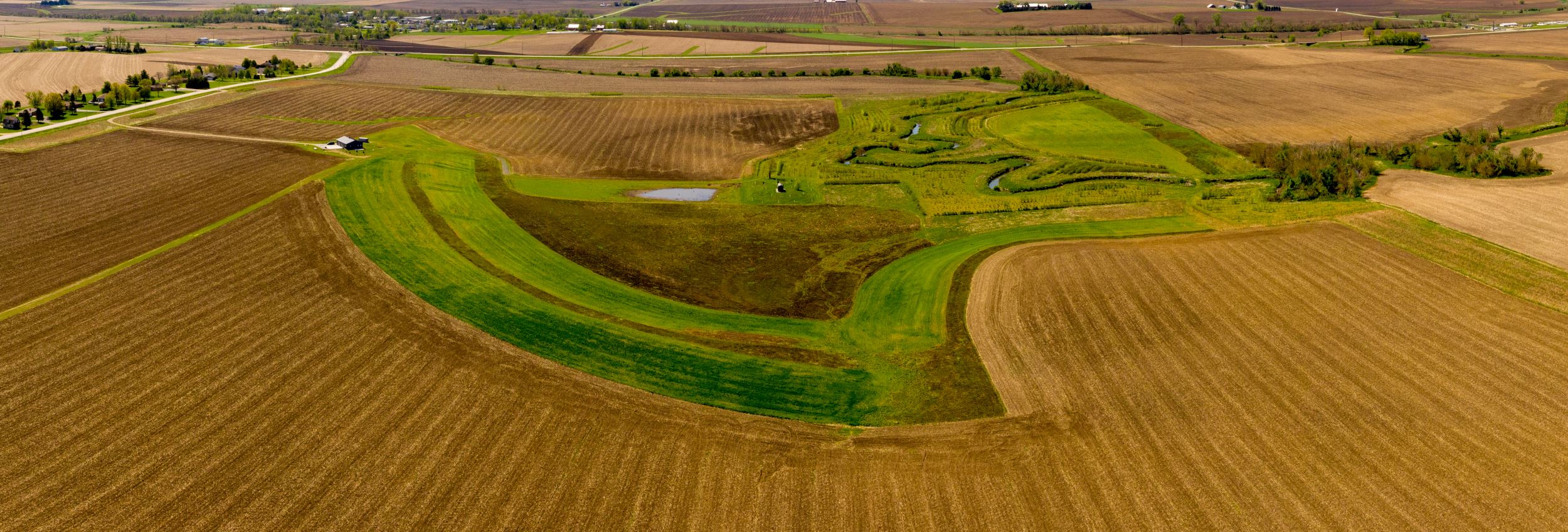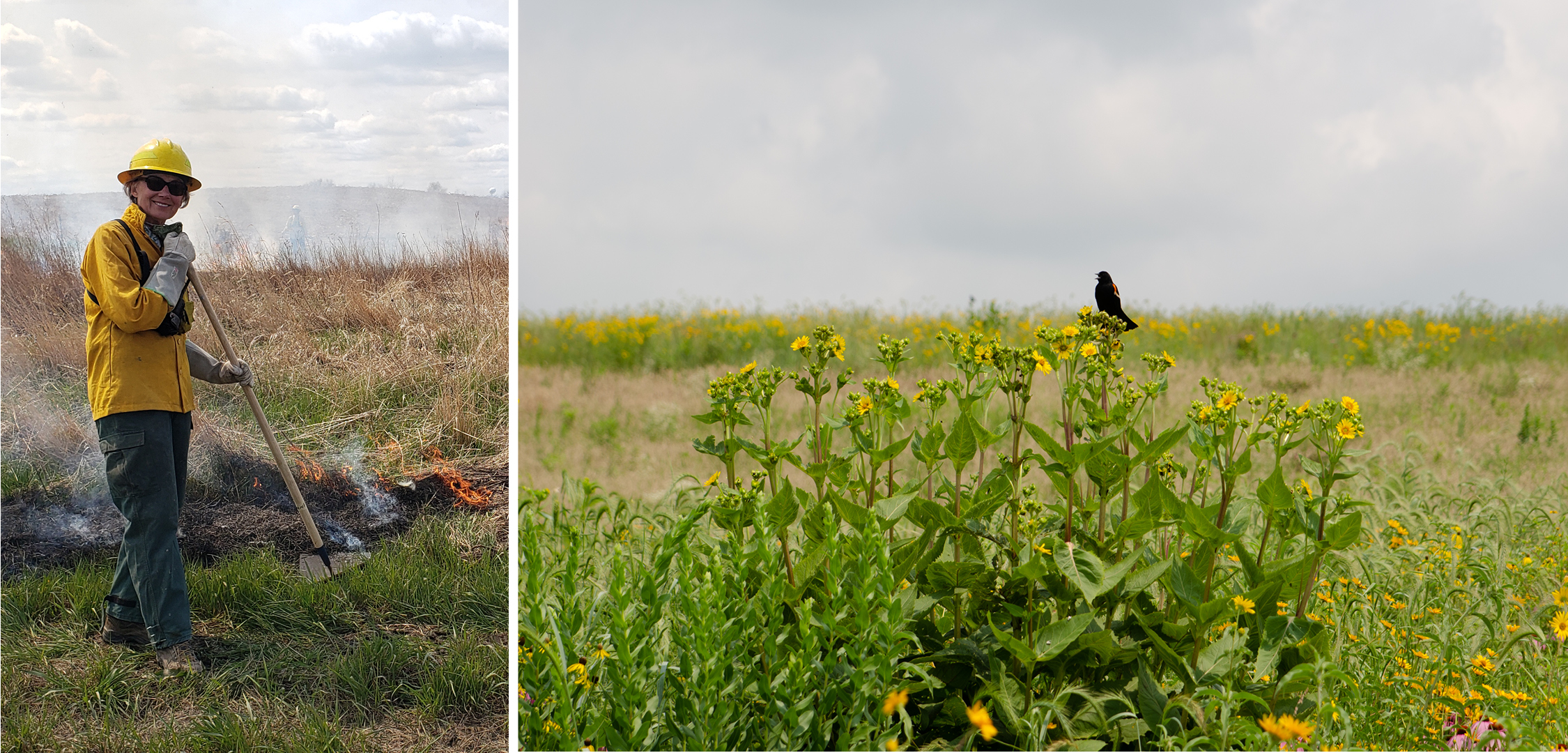Under Wild Skies
By Emily Martin on September 1, 2022 in Landowner Stories

Photo by Mike Fetterer
“We come and go, but the land is always here. And the people who love it and understand it are the people who own it–for a little while.” Willa Cather, O Pioneers!
There are those who remain steadfast in recapturing the wilderness that once dominated the Great Plains, the limitless skies and prairie which inspired the likes of Willa Cather and Aldo Leopold to exclaim to the world its beauty. Ann Werner is one of those stewards who sees the splendor of the land and has a vision for what future generations of humans and wildlife deserve.
“People in my generation do not have a relationship with prairie because we didn’t have prairies like Neal Smith [National Wildlife Refuge] in which to wander. So, we don’t know the wild beauty, the wonder, the joy of walking with big bluestem waving over our heads and wildflowers blooming underfoot. We have lost the ancient history of this land. The tallgrass prairie evolved over ten thousand years and was nearly lost in less than one generation, lost before it was written record. The loss of the largest native ecosystem in the U.S. to what we have now, is something I don’t even know how to take in. But I believe that Iowans can still do something big here,” said Werner.
Earlier this year, Werner made a leap forward in her vision by donating Lark Fields to INHF so it will be protected forever. Located in Scott County in eastern Iowa, Lark Fields is a diverse 237-acre farm intentionally designed with native prairie, trees and shrubs and a newly excavated wetland. But Lark Fields didn’t start this way. Werner first had to go on her own journey before she would be ready to take on the restoration of her heritage farm.
The Ties that Bind
Werner grew up with her two siblings where they played in their backyard and ravine in Davenport, Iowa. This was her first classroom where she observed nature. Werner’s parents, Jane and Clem, strongly valued conservation, becoming early supporters of INHF and Nahant Marsh Education Center.
“One of the gifts [my parents] gave us was showing humility to other people and to other species. That we were small in comparison and only here for a short time,” said Werner.
That humility would stick with Werner throughout her life, guiding her out West to deepen her study of the environment. Werner eventually put down roots in Oregon where she still lives today after a career in environmental planning and advocacy.
“Growing up, we drove by our farms on Sunday afternoons. In college, I’d come home often and we would see the farms but after my parents retired to Florida, I didn’t come to Iowa for 10 years,” said Werner.
Werner stayed in touch with Iowa through environmental newsletters where she learned about the criticisms Iowa faced for its loss of soil and habitat.
“After Mom died, my siblings and I decided to split the farms. While it made sense to trade my Iowa farm for a farm in Oregon where I lived, the opportunity to restore wildlife habitat in Iowa was too important to pass up,” said Werner.
A Plan Comes Together
Werner wasted no time getting to work on what would become Lark Fields. The property was originally purchased by her great grandparents in the 1920s and had been farmed since.
“Like most of the rich black soil in Scott County, the land was planted with two species for crops,” Werner said. “Because I was in my 60s, I wanted to fast-forward biological diversity so I could see results in my lifetime.”
One of Werner’s first steps was to learn what was possible by visiting land owned and stewarded by Curtis Lundy, chairman of the Nahant Marsh Education Center board of directors. It was Lundy who introduced her to the planning resources available through Natural Resources Conservation Service (NRCS) and Farm Service Agency (FSA). Shortly after visiting Lundy’s land, Werner worked with the NRCS to create a plan.
“With the ecological advice from experts, I hired contractors to plant thousands of native species of trees, shrubs, wetland plugs and to seed native grasses and forbs. I had some drainage tile removed from the farmed fields and a pond excavated,” said Werner.
Traveling back and forth between Oregon and Iowa throughout the restoration of Lark Fields, Werner enjoyed reconnecting with her Iowa roots. By day she worked at Lark Fields, and by night she traveled to her hometown of Davenport to rest. Werner reveled in looking to the wild skies as vast crackling thunderstorms rolled across the land.
“In Oregon, I missed the big wild beauty of Iowa’s sky: its storms, dramatic clouds, and extreme weather,” Werner reflected. It was in this time between spectacular sunrises, peaceful sunsets and tireless work that Werner chose the name Lark Fields. As Werner puts it, humans are here for a short time, but nature remains to greet future generations. That’s why the horned lark, a grassland specialist who lives year-round in Iowa, became the farm’s namesake.
“I like that Ann picked the Lark as a symbol – it likes openness but with transitional edge – that’s how it feels to be at Lark Fields. You’re tucked into safety with resources all around you,” said Abby Hade Terpstra, director of philanthropy for INHF.
Werner is quick to point out that the transformation of Lark Fields was extremely hard work and depended on the involvement of many. Natural resource specialists; private landowners; botanists; ecological consultants; certified prescribed burn experts; and the tenant who still farms a portion of the land. Werner was inspired to see so many Iowans wanting to return farmland to habitat together.
In total, 70 acres of the 237 are now diverse habitat, and the rest are farmed with conservation at its heart. In the last seven years, new life has found this oasis — birds, insects, rodents, mammals, amphibians — singing, swimming, flying, eating, nesting, resting, monarchs overnighting on trees on their migration and so much more.
 Ann Werner pictured during a prescribed burn next to a photo of a perched red-winged blackbird.
Ann Werner pictured during a prescribed burn next to a photo of a perched red-winged blackbird.
Using a phased approach, Werner has worked to restore Lark Fields using prescribed burning and planting thousands of trees, shrubs, grasses and wildflowers. Her work has resulted in birds, insects and other animals returning to the site, like this red-winged blackbird (Agelaius phoeniceus) perching on a stand of cup plant (Silphium perfoliatum).
Looking to the Future
With the land healing, Werner wanted to ensure Lark Fields would forever remain habitat for Iowa’s native species. Werner turned to the same organization her family had worked with years ago: INHF. This past spring, Werner made a charitable donation of all 237 acres to INHF to protect and steward forever.
“Living far away, I knew it was time to donate Lark Fields to an organization who had the capacity to manage it for long term success. That’s a tall order. I felt lucky to have an organization as mature and capable as INHF to take over the stewardship of Lark Fields,” said Werner.
“INHF recognizes the intensity of this personal decision. It has been truly fantastic to be able to develop a relationship with Ann as she considered making a gift of this magnitude,” said Hade Terpstra.
Werner hopes to see Lark Fields have the same impact on young people as her parents’ love for nature had on her. “The experiences we have when we are young stay with us and shape us. We need to protect wild lands now to ensure future generations have places to go. Lark Fields is an island of hope in a sea of corn and soybeans; what is desperately needed is the restoration of much more habitat in Iowa, on farmland and in backyards.”
Under INHF’s protection, Lark Fields will inspire generations to come so every Iowan may know what it’s like to see a native landscape filled with singing birds under wild skies.